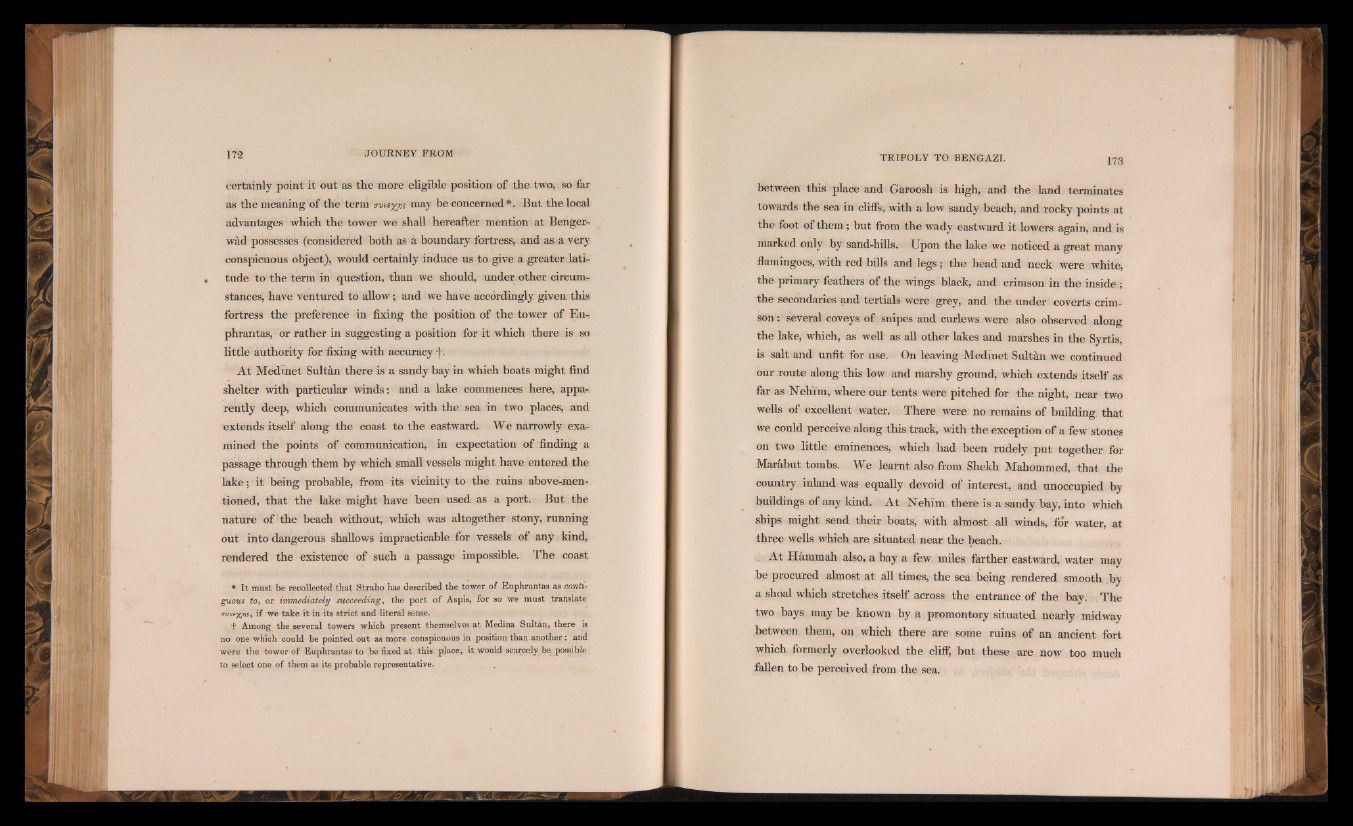
certainly point it out as the more eligible position of the two, so far
as the meaning of the term rvteyn; may be concerned*. But the local
advantages which the tower we shall hereafter mention at Benger-
w&d possesses (considered both as a boundary fortress, and as a very
conspicuous object), would certainly induce us to give a greater latitude
to the term in question, than we should, under, other circumstances,
have ventured to allow; and we have accordingly given this
fortress the preference in fixing the position of the tower of Eu-.
phrantas, or rather in suggesting a position for it which there is , so
little authority for fixing with accuracy j\
At MedTnet Sultitn there is a sandy bay in which boats might find
shelter with particular winds; and a lake commences here, apparently
deep, which communicates with the sea in two places, and
extends itself along the coast to the eastward. We narrowly examined
the points of communication, in expectation of finding a
passage through them by which small vessels might have entered the
lake; it being probable, from its vicinity to the ruins above-mentioned,
that the lake might have been used as a port. But the
nature of the beach without, which was altogether stony, running
out into dangerous shallows impracticable for vessels of any kind,
rendered the existence of such a passage impossible. The coast
* I t must be recollected that Strabo has described the tower of Euphrantas as contiguous,
to, or immediately succeeding, the port of Aspis, for so we must translate
awey/is, if we take it in its strict and literal sense.
•f Among the several towers which present themselves a t Medina Sult&n, there is
no one which could be pointed out as more conspicuous in position than another; and
were the tower of Euphrantas to be fixed a t this place, it would scarcely be possible
to select one of them as its probable representative.
between this place and Garoosh is high, and the land terminates
towards the sea in cliffs, with a low sandy beach, and rocky points at
the foot of them ; but from the wady eastward it lowers again, and is
marked only by sand-hills. Upon the lake we noticed a great many
flamingoes, with red bills and legs; the head and neck were .white,
the primary feathers of the wings black, and crimson in the .inside;
the secondaries and tertials were grey, and the under coverts crimson
: several coveys of snipes and curlews were also observed along
the lake, which, as well as all other lakes and marshes in the Syrtis,
is salt and unfit for use. On leaving Medinet Sultan we continued
our route along this low and marshy ground, which extends itself as
far as NehTm, where our tents were pitched for the night, near two
wells of excellent water. There were no remains of building that
we could perceive along this track, with the exception of a few stones
on two little eminences, which had been rudely put together for
Marhbut tombs. We learnt also from Shekh Mahommed, that the
country inland was equally devoid of interest, and unoccupied by
buildings of any kind. At Nehlm there is a sandy bay, into which
ships might send their boats, with almost all winds, for water, at
three wells which are situated near, the beach.
. At Hammah also, a bay a few miles farther eastward, water may
be procured almost at all times, the sea being rendered smooth by
a shoal which stretches itself across the entrance of the bay. The
two bays may be known by a promontory situated nearly midway
between them, on which there are some ruins of an ancient fort
which formerly overlooked the cliff, but these are now too much
fallen to be perceived from the sea.